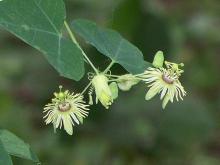Wildflowers, Grasses and Other Nonwoody Plants
Media

Species Types
Scientific Name
Dioscorea oppositifolia (sometimes called D. batatas)
Description
Similar to kudzu, Chinese yam is an aggressive vine that overtakes nearly everything within reach that stands still long enough! Learn more about this invasive plant — and please don’t plant it!
Media

Species Types
Scientific Name
Passiflora lutea
Description
Yellow passion flower is the smaller of Missouri’s two Passiflora species. Both are vines that climb via tendrils. This one has yellowish-green flowers about an inch wide. Look for it along and south of the Missouri River.
Media

Species Types
Scientific Name
Mimosa quadrivalvis (also Schrankia nuttallii)
Description
Sensitive briar is a dainty-looking legume with delicate, twice-compound leaves and flower heads resembling magenta pom-poms. The long, tough stems are covered with tiny thorns that snag your feet as you walk.
Media

Species Types
Scientific Name
Matelea decipiens
Description
The brown, starlike, spreading flowers of climbing milkweed differ from those of other milkweeds, but milky sap, warty pods with silk-tasseled seeds, and the structures in the center of the flowers show its true alliance.
Media

Species Types
Scientific Name
Subfamily Asclepiadoideae
Description
Milkweeds are a group of plants that used to have their very own family. Now part of the dogbane family, they’re still a pretty distinctive group.
See Also
About Wildflowers, Grasses and Other Nonwoody Plants in Missouri
A very simple way of thinking about the green world is to divide the vascular plants into two groups: woody and nonwoody (or herbaceous). But this is an artificial division; many plant families include some species that are woody and some that are not. The diversity of nonwoody vascular plants is staggering! Think of all the ferns, grasses, sedges, lilies, peas, sunflowers, nightshades, milkweeds, mustards, mints, and mallows — weeds and wildflowers — and many more!





















